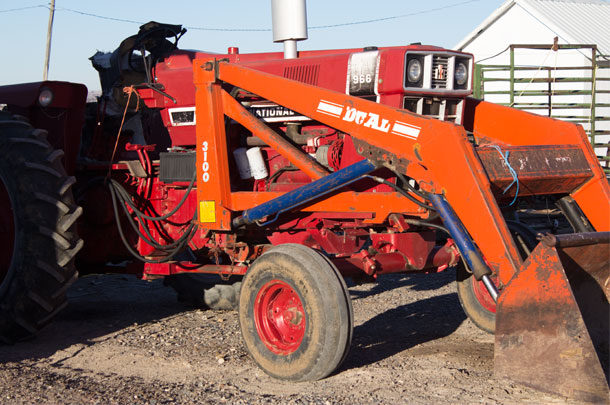Okay, maybe pizzas are a stretch, but tractor prices have historically improved with personalization, according to Greg Peterson (better known as Machinery Pete).
Peterson has been tracking auction prices for agricultural equipment in the U.S. and Canada for better than 20 years, and he encouraged an audience of more than 300 at the 50th National Farm Machinery Show in Louisville, Kentucky, to personalize their equipment in a variety of ways to increase resell value.
That can be done as easily as taking out your cell phone and snapping a picture or short video of your equipment working in the field.
Peterson said, “Auction prices show personalizing it brings stronger prices.” And it’s not just a sales gimmick. “It’s a piece of who we are,” Peterson said, and that “piece” is a bonus to the value of the metal. When a potential buyer looks at machinery (whether at a dealer, auction or private sale), if there is a video or snapshot of that machine working in the field with a name and a face of the previous owner to go with it, it can help sell the equipment.
Peterson gave an overview of equipment trends, indicating that auction prices of used equipment in general run 72 to 78 percent of new equipment (dealer-advertised pricing).
What’s hot
Peterson said old pickups have taken off in the last year and a half. Buyers want “just the look of them,” which is what seems to be making them popular.
Good buyer demand has also continued for smaller tractors. Tractors in the 130 to 200 horsepower range are holding strong and continue to set new record highs.
Older tractors in good condition are bringing big prices. Peterson said John Deere 4020s and other older tractors are not slowing down at all.
What’s not
Beginning in August and September 2014, auction prices dropped 15 to 25 percent on late model, high-capacity, used equipment such as combines and choppers. Peterson reported that trend was across all equipment brands and geographic locations.
Overall auction prices for the previous 11 years increased in the fourth quarter; however, in 2014 equipment prices leveled. Peterson said combine prices drifted lower in the last quarter of 2014 but started to solidify again in late 2014, likely due in large part to the Section 179 tax extension passed by Congress in late December. Peterson said Section 179 “has become an animal” and is “too powerful” for influencing farm equipment prices.
Hay and forage equipment has had a long, continued rise in auction prices over the last several years, but Peterson said these values have halted.
Predictions
Peterson predicts first quarter 2015 equipment auction prices will stay fairly strong until about St. Patrick’s Day, when historically auction prices have softened. Prices tend to remain soft from mid-March through September. Old tractors in good condition will continue to bring good prices in all parts of the country.
Changing auction dynamics
The Internet has certainly changed equipment movement throughout the country, Peterson said. It’s not unusual for a buyer in North Dakota to find farm equipment on an auction in North Carolina and send in a bid.
Peterson said, “If you want to sell, get it on the Internet. Geography means so much less these days.” While on-farm auctions are decreasing in number, Peterson said, “Traditional on-site auctions with online bidding do the best.”
Getting top dollar
For auction timing, Peterson said, “If I was having a sale, the first of November is when I’d have it. Over the last six years, this has been the strongest period.” At that point, farmers likely know what their harvest yield is, and income for the year.
Returning to the personalization theme, Peterson also encouraged sellers who want to receive top dollar for farm equipment to “tell your story.” Equipment at auction or on a dealer’s lot still sells better when the buyer can put a name or face to the equipment.
Peterson said not long ago, he was at an equipment auction and heard an exchange similar to this:
“Why is the paint touched up on this equipment, and it even has new rubber?”
And the reply was, “Well, you have to know Dean.”
In this case, Dean wanted everyone to feel like they had a “new” piece of equipment when they took it home from his auction. And that’s the personalization that Peterson stressed makes a difference at the auction.
Peterson encouraged farmers to keep meticulous records in order to receive higher prices – keep a list of maintenance checkpoints and parts replacements. In that respect, it’s not unlike selling a home; if you can provide dates and records of a chimney sweep, a new roof or water heater and maybe paint the shutters, it matters.
Peterson explained that people know people, and trust increases with a little personalization by video, snapshots or extended records. When personalized, a piece of equipment is not sold just as a model number or piece of metal; instead it’s “Mac’s tractor” or “Joe’s outfit.” FG
PHOTO
Photo by Lynn Jaynes.










